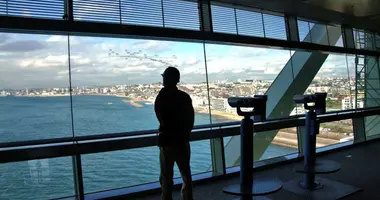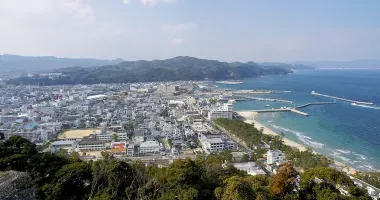Yumebutai Awaji: A multifaceted architectural marvel on Awaji Island
- Published on : 18/04/2024
- by : Japan Experience
- Youtube
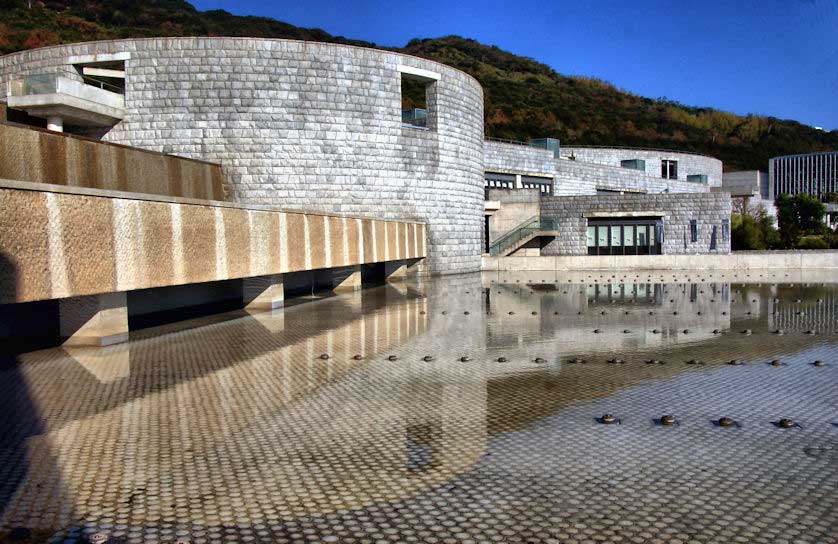
The Shell Garden, a series of shallow pools with one million seashells at Tadao Ando's Awaji Yumebutai on Awaji Island
Nestled on the picturesque Awaji Island, Yumebutai stands as a testament to architectural innovation and cultural significance. Designed by world-renowned architect Tadao Ando, this sprawling complex seamlessly blends modern design with natural beauty. Yumebutai, which translates to "Dream Stage," offers visitors a unique experience that combines art, nature, and functionality. From its striking concrete structures to its meticulously planned gardens, Yumebutai captivates with its harmonious integration of man-made elements and the surrounding landscape. As we explore this architectural marvel, we'll uncover the vision behind its creation, delve into its diverse attractions, and discover why it has become a must-visit destination for architecture enthusiasts and nature lovers alike.
The vision and history behind Yumebutai Awaji
The story of Yumebutai begins with a transformation of devastation into beauty. Originally a wasteland created by extensive soil excavation for the construction of Kansai International Airport, the site caught the attention of Tadao Ando in the early 1990s. Ando envisioned a project that would not only reclaim the damaged land but also create a space where people could connect with Japanese culture and nature.
However, the 1995 Great Hanshin-Awaji Earthquake dramatically altered the course of the project. With the epicenter near Awaji Island, Ando decided to incorporate a memorial aspect into the design, honoring the victims of the disaster. This shift in purpose added a profound layer of meaning to Yumebutai, transforming it from a simple reclamation project into a symbol of resilience and hope.
Completed in 2000, Yumebutai emerged as a multifaceted complex that includes a conference center, hotel, memorial, gardens, and various public spaces. Ando's design philosophy of creating harmony between architecture, nature, and human needs is evident throughout the site, making Yumebutai a living example of his architectural principles.
Exploring the unique architectural elements of Yumebutai
Tadao Ando's signature style is prominently displayed throughout Yumebutai. The use of exposed concrete, a material Ando is famous for, creates a stark yet elegant backdrop for the natural elements incorporated into the design. Geometric shapes feature prominently, with rectangles, circles, and triangles forming the basis of various structures within the complex.
One of the most striking features is the interplay between light and shadow, a hallmark of Ando's work. Carefully placed openings and corridors allow natural light to create ever-changing patterns throughout the day, bringing the structures to life. The architect's mastery in manipulating space is evident in the way visitors are guided through the complex, with each turn revealing new vistas and perspectives.
Water plays a crucial role in Yumebutai's design, reflecting Ando's belief in its spiritual significance. Shallow pools, cascading waterfalls, and serene ponds are integrated throughout the site, creating a sense of tranquility and connecting the built environment with the natural world. The Shell Garden, featuring one million seashells in shallow pools, exemplifies this harmonious blend of artificial and natural elements.

The Water Garden, part of the Yumebutai complex designed by Ando Tadao
Key attractions within the Yumebutai complex
At the heart of Yumebutai lies the Hyakudanen or "100 Stepped Gardens," a breathtaking cascade of 100 flower beds arranged in terraces up the hillside. Each 4.5-meter square garden is meticulously planted with seasonal flowers, creating a living tapestry that changes throughout the year. Visitors can ascend the 235 staircases or take an elevator to enjoy panoramic views of the complex and Osaka Bay beyond.
The Hyakudanen Garden is not just a visual spectacle but also serves as a poignant memorial. The 100 gardens symbolize hope and renewal, offering a space for reflection and remembrance of those affected by the 1995 earthquake.
Another major attraction is the Miracle Planet Museum of Plants, previously known as the Kiseki no Hoshi Botanical Museum. This 6,700-square-meter greenhouse is one of Japan's largest, housing a diverse collection of plant species from around the world. Visitors enter via a unique elevated walkway, providing a bird's-eye view of the lush greenery below before descending to explore various themed sections, including a tropical garden, a desert area, and spaces dedicated to ferns and seasonal flower displays.
The Oval Forum and Circular Forum offer striking examples of Ando's geometric designs, providing spaces for gatherings and performances. The open-air theater, with its backdrop of sky and sea, creates a natural amphitheater for cultural events.
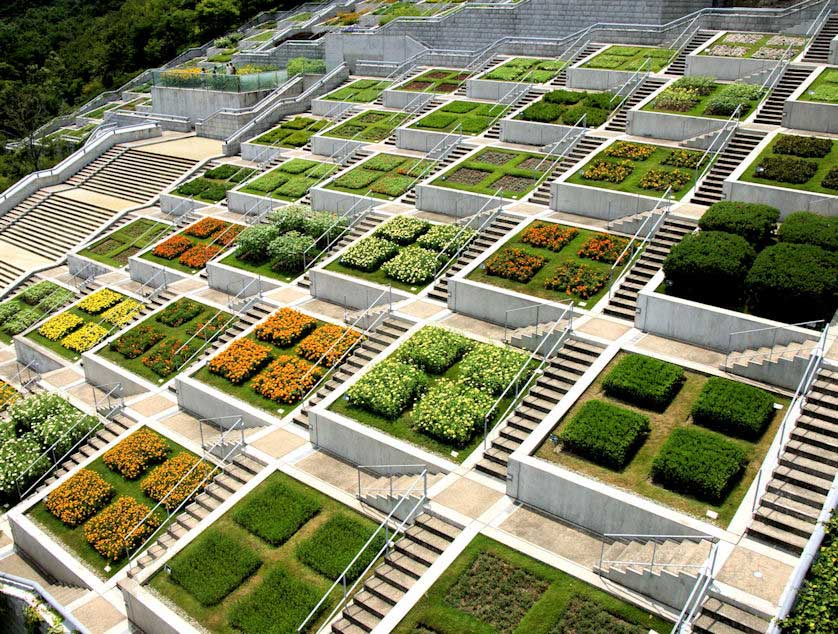
The Hyakudanen, 100 stepped gardens cascading down the hillside at Awaji Yumebutai
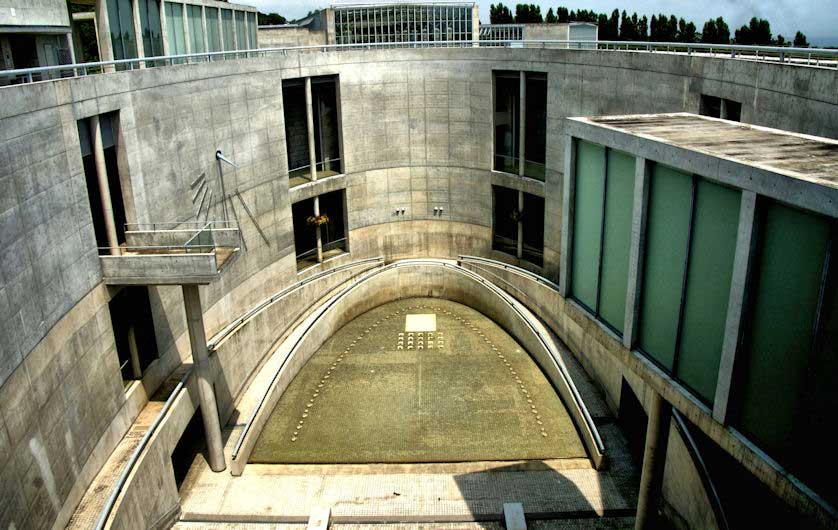
The Oval Forum by Tadao Ando, part of Yumebutai on Awaji Island
The Westin Awaji Island Resort: Luxury and convenience
An integral part of the Yumebutai complex is the Westin Awaji Island Resort. Designed to resemble a ship sailing through the wind, this luxury hotel offers guests a unique stay experience. Every room boasts a view of Osaka Bay, allowing visitors to fully immerse themselves in the coastal landscape.
The hotel's design seamlessly integrates with the surrounding environment. Much of the low-rise structure's roof is covered with vegetation, creating the illusion that guest rooms are perched atop a lush green hill. This approach not only enhances the aesthetic appeal but also demonstrates Ando's commitment to blending architecture with nature.
With 200 rooms available in both Western and Japanese styles, the Westin caters to a variety of preferences. The hotel gained international recognition when it hosted David Beckham and the England football team during the 2002 World Cup. Among its unique features is a traditional tea ceremony room, offering guests an authentic taste of Japanese culture.
The resort also houses conference facilities, making it an ideal location for both leisure and business travelers. Its integration within the larger Yumebutai complex allows guests easy access to all the attractions and amenities on offer.
Connecting with nature: Gardens and outdoor spaces at Yumebutai
Beyond the Hyakudanen, Yumebutai offers a variety of outdoor spaces that showcase the beauty of Awaji Island's natural environment. The Water Garden, another Ando masterpiece, features a series of reflective pools that mirror the sky and surrounding structures, creating a sense of infinite space and tranquility.
Adjacent to Yumebutai is the Akashi Kaikyo Park, a more traditional green space that complements the modern design of Ando's complex. This park offers seasonal flower displays, expansive lawns perfect for picnicking, and a large lake where visitors can rent boats. It provides a different but equally enjoyable nature experience, with play areas for children and ample space for relaxation.
For those seeking a more immersive nature experience, woodland walks lead from the Hyakudanen to higher observation points. These paths offer visitors a chance to explore the local flora and enjoy sweeping views of the Seto Inland Sea and the impressive Akashi Kaikyo Bridge.
The integration of these varied green spaces within and around Yumebutai underscores Ando's vision of creating an environment where people can reconnect with nature. Whether it's the carefully manicured gardens or the wilder woodland areas, visitors have ample opportunity to experience the natural beauty of Awaji Island.
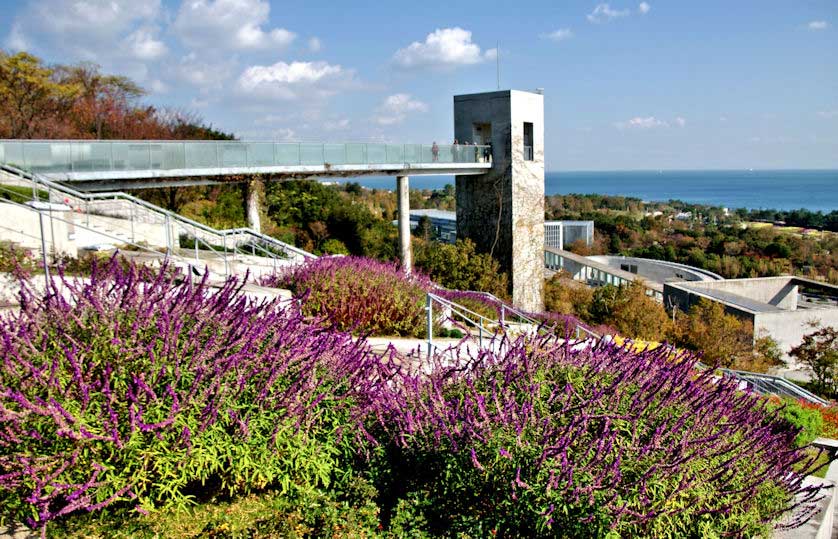
Above the Hyakudanen Garden at Yumebutai with views across Osaka Bay
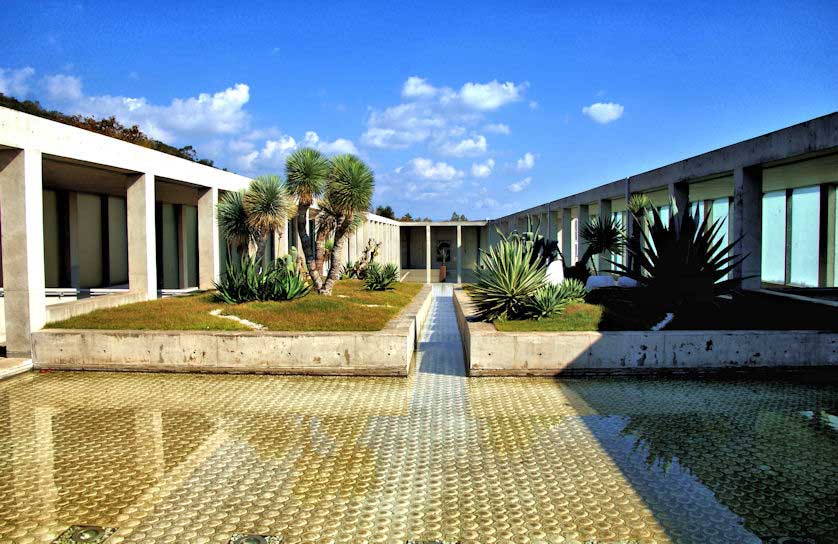
Somewhat reminiscent of a Roman villa, the Hillside Gallery at Awaji Yumebutai
How to access Yumebutai Awaji
Reaching Yumebutai is relatively straightforward, with several transportation options available. The most common route is by express bus from major cities in the Kansai region. From Shin-Kobe or Sannomiya Stationin Kobe, a 60-minute bus ride takes visitors directly to Yumebutai. These buses are bound for Higashiura Bus Terminal and make a stop at the Yumebutai complex.
For those coming from further afield, such as Osaka or Kyoto, taking a train to Kobe and then transferring to the express bus is the most efficient route. Visitors arriving at Kansai International Airport can also find direct bus services to Awaji Island.
Another scenic option is to take a high-speed boat from Akashi Port to Iwaya Port on Awaji Island, followed by a short bus ride to Yumebutai. This route offers beautiful views of the Akashi Kaikyo Bridge and the Seto Inland Sea.
For those driving, Yumebutai is easily accessible via the Kobe-Awaji-Naruto Expressway. The complex has ample parking available for visitors arriving by car.
Planning your visit: Practical information and nearby attractions
When planning a visit to Yumebutai, it's worth noting that while entry to the main complex is free, some attractions like the Miracle Planet Museum of Plants have separate admission fees. The museum is open from 10 am to 6 pm daily, with adult entry priced at 600 yen (subject to change for special exhibitions).
Visitors should allow at least half a day to fully explore Yumebutai, with a full day recommended to include the adjacent Akashi Kaikyo Park. Comfortable walking shoes are advisable, especially if you plan to climb the Hyakudanen steps.
For those wishing to extend their stay, the Westin Awaji Island Resort offers luxurious accommodation within the complex. Alternatively, there are various hotels and ryokans available in nearby towns on Awaji Island.
Awaji Island itself offers numerous attractions worth exploring. History enthusiasts might enjoy visiting Sumoto Castle, Japan's oldest reconstructed castle, or the Izanagi Jingu & Onokorojima Shrine, which are connected to Japan's creation myths. Nature lovers can explore the island's beautiful beaches or visit the Honpukuji Temple, another masterpiece by Tadao Ando known as the "Water Temple."
Yumebutai Awaji stands as a testament to the power of architectural vision and the resilience of the human spirit. It offers visitors a unique blend of modern design, natural beauty, and cultural significance. Whether you're an architecture enthusiast, a nature lover, or simply seeking a unique travel experience, Yumebutai promises an unforgettable journey through one of Japan's most innovative and inspiring landscapes.

